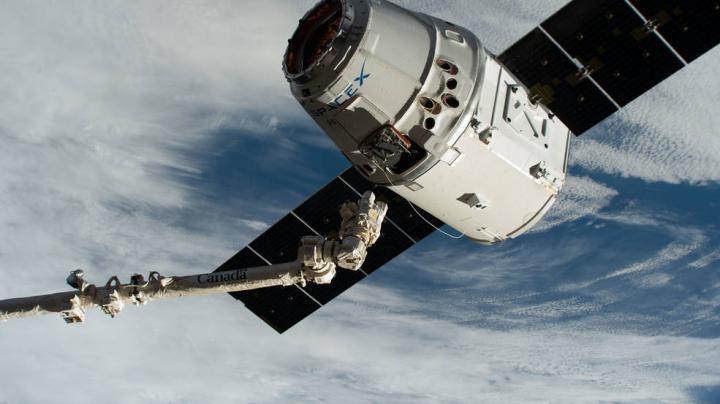31.05.2019

Filled with more than 4,200 pounds of valuable scientific experiments and other cargo, a SpaceX Dragon cargo spacecraft is set to return to Earth from the International Space Station Monday, June 3. NASA Television and the agency’s website will provide live coverage of the craft’s release beginning at 11:45 a.m. EDT.
Around noon, flight controllers at mission control in Houston will deliver remote commands to the station’s Canadarm2 robotic arm to detached Dragon from the Earth-facing port of the Harmony module. Expedition 59 Flight Engineer David Saint-Jacques of the Canadian Space Agency will back up the operation and monitor Dragon’s systems as it departs the orbital laboratory.
After firing its thrusters to move a safe distance away from the station, Dragon will execute a deorbit burn around 4:56 p.m. to leave orbit, as it heads for a parachute-assisted splashdown in the Pacific Ocean, 202 miles southwest of Long Beach, California, at 2:55 p.m. PDT. There will be no live coverage of deorbit burn or splashdown.
Dragon launched on the SpaceX Falcon 9 rocket May 4 from Space Launch Complex 40 at Cape Canaveral Air Force Station in Florida, and arrived at the station two days later.
Some of the scientific investigations Dragon will return to Earth include:
Observing Protein Crystal Growth
NASA’s Biophysics-6 experiment looks at the growth of two proteins of interest in cancer treatment and radiation protection. Scientists are using ground-based predictions and in-space X-ray crystallography to determine which proteins benefit from crystallization in microgravity, where some proteins can grow larger and with fewer imperfections.
Microalgae Biosynthesis in Microgravity
Microalgae Biosynthesis in Microgravity (MicroAlgae) studies the effects of microgravity on Haematococcus pluvialis, an algae capable of producing a powerful antioxidant, astaxanthin. It could provide a readily available dietary supplement to promote astronaut health on long-duration space exploration missions. A community college student and alumnae of the NASA Community College Aerospace Scholars (NCAS) program proposed the research, and NCAS is engaging community colleges across the U.S. to conduct ground studies for comparison to the in-orbit investigation.
Genes in Space
On May 23, astronauts aboard the space station successfully edited DNA using CRISPR/Cas9 technology for the first time in space, working on the Genes in Space 6 investigation. This milestone advances understanding of how DNA repair mechanisms function in space and supports better safeguards to protect space explorers from DNA damage. Genetic damage caused by cosmic radiation poses a serious risk to space travelers, especially those on long-duration missions to the Moon and Mars. CRISPR/Cas9 now joins a growing portfolio of molecular biology techniques available on the ISS National Lab.
These are just a few of the hundreds of investigations aimed at keeping astronauts healthy during space travel and demonstrating technologies for future human and robotic exploration beyond low-Earth orbit, including missions to the Moon by 2024 and on to Mars. Space station research also provides opportunities for other U.S. government agencies, private industry, and academic and research institutions to conduct microgravity research that leads to new technologies, medical treatments, and products that improve life on Earth.
For more than 18 years, humans have lived and worked continuously aboard the International Space Station, advancing scientific knowledge and demonstrating new technologies, making research breakthroughs not possible on Earth that will enable long-duration human and robotic exploration into deep space. A global endeavor, more than 230 people from 18 countries have visited the unique microgravity laboratory that has hosted more than 2,500 research investigations from researchers in 106 countries.
Quelle: NASA
----
Update: 1.06.2019
.
SpaceX Dragon set for ISS departure and Pacific Ocean splashdown
After a month at the International Space Station, a robotic SpaceX Dragon capsule that launched from Cape Canaveral in May will return for a Pacific Ocean splashdown early next week.
Packed with 4,200 pounds of scientific results for experts back on Earth, Dragon will be released from the station around noon Monday, kicking off its six-hour journey to just off the coast of California. Parachute-assisted splashdown is expected at 2:55 p.m. Pacific time.
The spacecraft launched on one previous mission – Commercial Resupply Services 12 in August 2017 – before its May 4 liftoff from Launch Complex 40. SpaceX's next mission to the ISS is expected no earlier than July.
Before that, however, the company is targeting June 22 for the high-profile launch of dozens of Department of Defense and NASA payloads on a Falcon Heavy rocket. The three-core vehicle will launch from Kennedy Space Center's pad 39A.
Quelle: Florida Today
